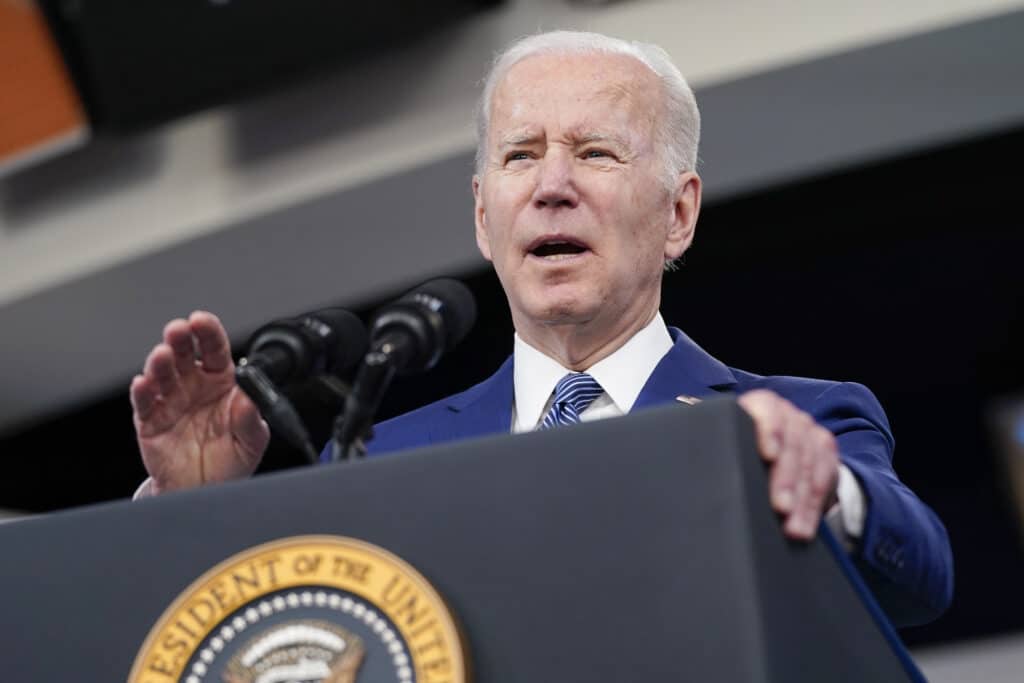For years, people have thought that allowing corporations to send jobs overseas helped stem inflation. But now that inflation is sky high, President Joe Biden believes bringing factory jobs back to the U.S. could quell inflation. The Associated Press has the story:
Biden: Globalization is stoking higher prices
WASHINGTON (AP) — President Joe Biden has a solution for high inflation that seems counterintuitive: Bring factory jobs back to the U.S.
This challenges a decades-long argument that employers moved jobs abroad to lower their costs by relying on cheaper workers. The trend contributed to the loss of 6.8 million U.S. manufacturing jobs since 2000, but it also translated into lower prices for consumers and put downward pressure on inflation in ways that kept broader economic growth going.
It was a trade-off that many corporate and political leaders were privately comfortable making.
Now, with inflation at a 40-year high, the president has begun to argue that globalization is stoking higher prices. That’s because proponents of outsourcing failed to consider the costs of increasingly frequent global supply chain disruptions. Recent disruptions have included the COVID-19 pandemic, shortages of basic goods like semiconductors, destructive storms and wildfires and, now, the Russian invasion of Ukraine, which has sent oil prices soaring.
Biden says the federal government can pursue two courses on inflation. It can either pull back on support and cause wages and growth to cool, or it can get rid of the pressure points that can lead to inflation when emergencies and uncertainties occur by having more goods manufactured in the U.S.
“Making it in America is one of the ways we can address our cost and supply chain challenges,” Biden said Wednesday. “When we build products we need, we don’t have to wait and we reduce shipping costs and we can get goods moving faster.”
The president then unspooled his thinking at a White House event with Commerce Secretary Gina Raimondo, state governors and business leaders. They gathered to stress the importance of finalizing a bill that would commit funds to encourage the domestic manufacturing of computer chips, which was one of the key bottlenecks that led to higher prices for autos, appliances and other goods last year.
But this plan would take years to implement and the consumer price report being released Thursday is expected to show that annual inflation rose to nearly 8% last month, according to the financial data firm FactSet.
Biden’s challenge is that he’s got long-term plans on inflation to address pain that consumers are feeling each day, said Douglas Holtz-Eakin, president of the center-right American Action Forum, who described Biden’s plan as “optics.”
“Semiconductor manufacturing facilities take years to build,” he said. “Inflation’s here now, and it’s it’s an issue now.”
Biden’s assertion sets up an ideological battle with Republicans, who blame the president’s $1.9 trillion coronavirus relief package for being excessive and flushing more cash into the U.S. economy than was needed. GOP lawmakers have said inflation — up from recent averages of about 2% — is entirely the president’s fault, while the administration is trying to say the bigger problem rests with the structure of the global economy.
House Republican leader Kevin McCarthy and others said last week that inflation — especially for gasoline — was the key source of the nation’s angst ahead of this year’s midterm elections.
“You don’t need a speech to know what the state of the union is. You feel it every time you go to the grocery store and the gas pump,” McCarthy said on Twitter.
Critics see this new Biden effort as largely an attempt at political damage control, rather than a data-driven approach to reducing inflation.
“It’s primarily about optics,” said Scott Lincicome, director of economics and trade at the libertarian Cato Institute. “The Biden administration clearly knows that inflation is a political albatross. And they are looking for anything and everything to show American voters that they have a plan to fix the problem.”
Lincicome argues that the vast majority of inflation is caused by Federal Reserve efforts to boost growth, Biden’s relief package and the general challenges of restarting an economy after the pandemic. Restoring factory jobs that went elsewhere would not address those challenges and any arguments for that are based on the belief that supply chain disruptions have become a permanent feature of the global economy, he says.
“Global supply chains lower costs and increase efficiency,” Lincicome said. “The idea that reshoring will somehow lower costs assumes a permanent pandemic situation and that’s just not reality.”
The Biden administration, for its part, is making that exact argument — supply chain disruptions are becoming more common and weighing on prices in ways that companies previously failed to consider.
The White House contends that the existing setup of the U.S. economy makes it vulnerable to disruptions that drive up prices. When companies first sent jobs overseas, they failed to fully account for the possible setbacks and challenges that can occur overtime with distant factories.
People were not accounting for increased “risks and disruption, and they weren’t thinking about five-, 10-year horizons,” said Sameera Fazili, deputy director of the White House National Economic Council. “They were looking at minimizing costs over a one-year horizon, two-year horizon.”
The administration is basing its argument, in part, on analyses done by the McKinsey Global Institute. A 2020 report by the institute found that companies will likely experience supply chain disruptions lasting a month or longer every 3.7 years, which increases costs and cuts into profits.
The risks examined in the report range from a “supervolcano” to a “common” cyberattack. There are political risks as well, as 29% of all global trade in 2018 came from countries ranked in the bottom half of political stability by the World Bank, an increase from 16% in 2000.
By JOSH BOAK







